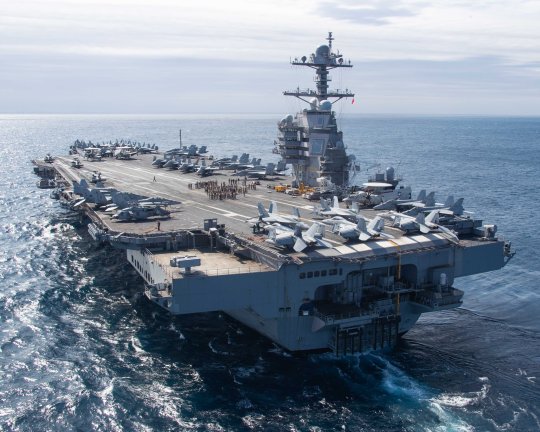#uss gerald r. ford
Explore tagged Tumblr posts
Text

CVN-78 Carrier airflow study in fluid mechanics lab
Date: January 6, 2004
NASA ID: ARC-2004-ACD04-0002-002
#USS GERALD R. FORD (CVN-65)#USS GERALD R. FORD#Gerald R. Ford Class#Ford Class#Aircraft Carrier#Warship#Ship#United States Navy#U.S. Navy#US Navy#USN#Navy#January#2004#my post
9 notes
·
View notes
Text
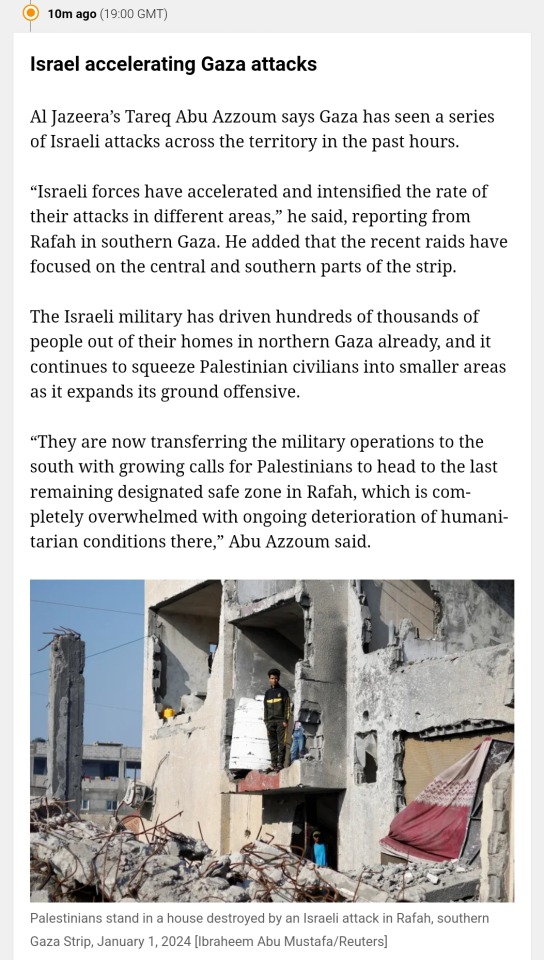
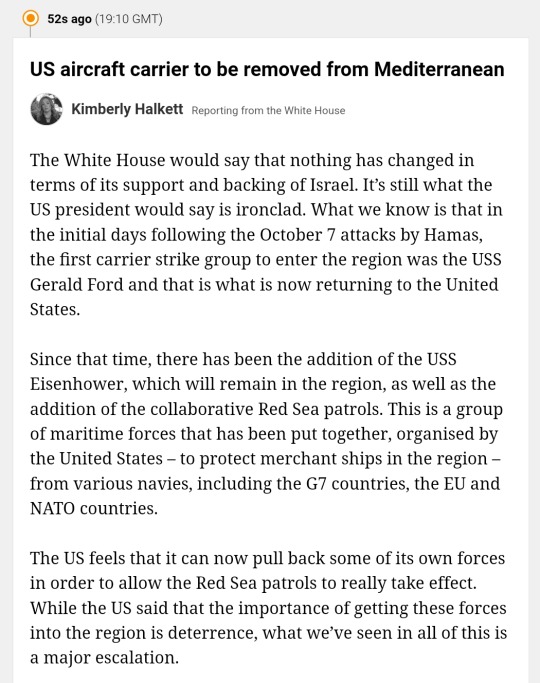
An escalation in Apartheid Israeli attacks, and a US carrier-withdrawal in the Red Sea
#free gaza#free palestine#gaza strip#irish solidarity with palestine#palestine#gaza#news on gaza#al jazeera#boycott israel#israel#Tareq Abu Azzoum#Rafah#uss gerald r. ford#USS Eisenhower
20 notes
·
View notes
Text

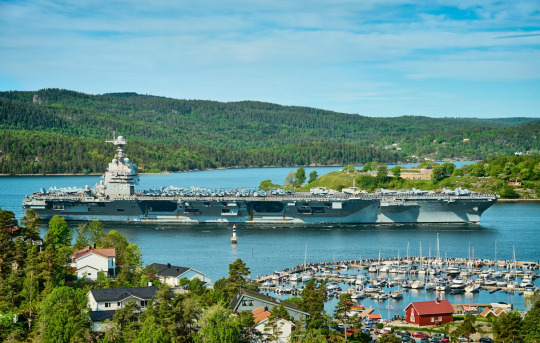

USS Gerald R. Ford at Drøbak Sound, Drøbak, Frogn Municipality, Akershus County, Norway
Vidar Nordli-Mathisen
#Drøbak Sound#Drøbak#Frogn Municipality#Akershus County#Norway#Europe#USS Gerald R Ford#USS Gerald R. Ford#US Navy#Navy#Military#Warship#Naval#Battleship
7 notes
·
View notes
Text
The real world but the USS Gerald R. Ford carrier task force is going to Gaza to establish a UN-mandated no-fly zone, begin humanitarian operations, and serve as the first wave of an international peacemaking mission
#and boy howdy are the Marines just slavering for a chance to do a beach assault under fire#oorah#gaza strip#to write an essay in the tags:#it might be time to do an imperialism towards our client state#israel#uss gerald r. ford#politicking#shower thoughts
16 notes
·
View notes
Text
“In any serious strategic calculus, the “Samson Option” refers not just to a last-resort spasm of pure national vengeance, but to a purposeful set of specific operational threats. When examined together with Israel’s still intentionally ambiguous nuclear strategy (a doctrine most commonly referred to as Israel’s “bomb in the basement”), it becomes evident that these carefully fashioned threat postures are designed to enhance Israeli nuclear deterrence. Indeed, any such enhancement would represent this unique doctrine’s most obvious raison d’être. But are there further steps that would enhance the Samson Option’s effectiveness in this context?
There is more. Because strategic crises in other parts of the world could sometime “spill over” into the ever-unpredictable Middle East, dedicated strategic planners in Tel Aviv should already begin their preparations to “think Samson.” This is especially the case wherever the possible “spill” could concern the threat or actual use of nuclear weapons.
(…)
Among other things, this means meticulously conceptualizing—or perhaps re-conceptualizing—the prospective role of any calculated Samson Option.
Whatever this option’s more precisely nuanced goals, its key objective must always remain exactly the same. That objective is to help keep Israel “alive.” In this duly considered objective, Israeli policy must very conspicuously deviate from the otherwise useful biblical metaphor—Samson, after all, lost his own life when he tore down the temple on his Philistine captors—drawn illustratively here from the book of Judges.
Ultimately, in relevant military nuclear matters, “Samson” must be about how to best manage certain urgent processes of strategic dissuasion. Here, the primary point of Israel’s nuclear forces must always be deterrence ex ante, not revenge ex post. For now, at least, Israel’s presumed nuclear strategy, while not yet articulated in any precise or publicly ascertainable fashion, is likely oriented toward nuclear war avoidance, not nuclear war fighting. From all potentially concerning standpoints, including even the well-being of Israel’s pertinent national adversaries, this is the indisputably correct orientation.
At its conceptual analytic core, the Samson Option references a deterrence doctrine based upon certain implicit threats of overwhelming nuclear retaliation or counter-retaliation—responses for more-or-less expected enemy aggressions. Any such doctrine could reasonably enter into force only where the responsible aggressions had first credibly threatened Israel’s physical existence. In other words, considered as a potentially optimal element of dissuasion, it would do Israel little good to proffer “Samson-based threats” in response to “ordinary” or manifestly less than massive forms of anticipated enemy aggression.
(…)
The bottom-line reasoning here is as follows: Exercising a Samson Option is not likely to deter any aggressions short of nuclear and/or massively large-scale conventional or biological first strikes.
All things considered, Samson’s overriding rationale must be to bring the following clear message to all identifiably potential attackers: “Israel may sometime have to accept mega-destructive attacks, but it surely won’t allow itself to ‘die with the Philistines’ or become the combatant country to suffer more dire consequences.” By emphasizing some overtly symmetrical exposure prospects to existential harms—”Israel won’t die alone”—the Samson Option could continuously serve Israel as a distinctly meaningful adjunct to nuclear deterrence and also to certain more-or-less corollary preemption options.
Significantly, the Samson Option could never protect Israel as a fully comprehensive nuclear strategy unto itself. This option must also never be confused with Israel’s more generalized, or “broad spectrum,” nuclear strategy, one which must always seek to maximize national deterrence at recognizably less apocalyptic levels of possible military engagement.
(…)
Concerning long-term Israeli nuclear deterrence, recognizable preparations for a Samson Option could help to best convince certain designated enemy states that massive aggressions against Israel would never be gainful. This stance could prove especially compelling if Israeli “Samson” weapons were (1) coupled with some level of nuclear disclosure (thereby effectively ending Israel’s longstanding posture of nuclear ambiguity); (2) to appear sufficiently invulnerable to enemy first strikes; and (3) plainly counter-city/counter-value in their declared mission function. Furthermore, in view of what nuclear strategists sometimes refer to as the “rationality of pretended irrationality,” Samson could more generally enhance Israeli nuclear deterrence by demonstrating an apparently tangible Israeli willingness to take various existential risks.
To a manifestly variable and possibly even bewildering extent, the nuclear deterrence benefits of “pretended irrationality” could sometime depend upon a prior enemy state awareness of Israel’s counter-city or counter-value targeting posture. Worth noting here is that such a posture had been expressly recommended more than fifteen years ago by the private “Project Daniel Group,” in its then confidential report to Israeli Prime Minister Ariel Sharon. At present, it would appear plausible that this posture is also actual policy.
(…)
In those cases concerning Samson and Israeli nuclear deterrence, any recognizable last-resort nuclear preparations could enhance Israel’s preemption options by underscoring a singularly bold national willingness to take presumptively existential risks.
(…)
If left to themselves, neither deterred nor preempted, certain enemies of Israel (especially after any nuclear strike or exchange elsewhere on the planet) could convincingly threaten to bring the Jewish state face-to-face with the familiar torments of Dante’s Inferno, “Into the eternal darkness, into fire, into ice.” Such a portentous scenario has been made even more probable by the latest geostrategic strengthening of Iran in certain parts of Syria, Lebanon, Iraq and Yemen. This strengthening is taking place despite the US president’s withdrawal from the July 2015 JCPOA, or perhaps even because of this unilateral American abrogation.
At some point, various ominous intersections between a US-North Korean war and an expanding Iran-Hezbollah offensive could create wholly unprecedented perils for Israel. All such intersections, moreover, would be taking place within the broadly uncertain context of a second Cold War.
In extremis atomicum, these synergistic hazards could sometime become so unique and formidable that employing a Samson Option would seemingly represent the best available strategic option for Israel. In a more carefully structured world order, Israel would have no need to augment or even maintain its arsenal of deterrent threat options—especially the most perilous nuclear components—but this more ideal reconfiguration of world politics is still a long way off. Nonetheless, at some point, Israel, together with other future-oriented states, will somehow have to collaborate toward the incremental replacement of Realpolitik (power-politics) or “Westphalian” dynamics of international interaction, an intellectual collaboration that would largely be based upon a too long-delayed awareness that our earth is best conceptualized as an organic whole.”
“Iranian security officials helped plan Hamas’s Saturday surprise attack on Israel and gave the green light for the assault at a meeting in Beirut last Monday, according to senior members of Hamas and Hezbollah, another Iran-backed militant group.
Officers of Iran’s Islamic Revolutionary Guard Corps had worked with Hamas since August to devise the air, land and sea incursions—the most significant breach of Israel’s borders since the 1973 Yom Kippur War—those people said.
Details of the operation were refined during several meetings in Beirut attended by IRGC officers and representatives of four Iran-backed militant groups, including Hamas, which holds power in Gaza, and Hezbollah, a Shiite militant group and political faction in Lebanon, they said.
(…)
A direct Iranian role would take Tehran’s long-running conflict with Israel out of the shadows, raising the risk of broader conflict in the Middle East. Senior Israeli security officials have pledged to strike at Iran’s leadership if Tehran is found responsible for killing Israelis.
The IRGC’s broader plan is to create a multi-front threat that can strangle Israel from all sides—Hezbollah and the Popular Front for the Liberation of Palestine in the north and Palestinian Islamic Jihad and Hamas in Gaza and the West Bank, according to the senior Hamas and Hezbollah members and an Iranian official.
At least 700 Israelis are confirmed dead, and Saturday’s assault has punctured the country’s aura of invincibility and left Israelis questioning how their vaunted security forces could let this happen.
(…)
Iran has been setting aside other regional conflicts, such as its open feud with Saudi Arabia in Yemen, to devote the IRGC’s foreign resources toward coordinating, financing and arming militias antagonistic to Israel, including Hamas and Hezbollah, the senior Hamas and Hezbollah members said.
(…)
The strike was intended to hit Israel while it appeared distracted by internal political divisions over Prime Minister Benjamin Netanyahu’s government. It was also aimed at disrupting accelerating U.S.-brokered talks to normalize relations between Saudi Arabia and Israel that Iran saw as threatening, the senior Hamas and Hezbollah members said.
Building on peace deals with Egypt and Jordan, expanding Israeli ties with Gulf Arab states could create a chain of American allies linking three key choke points of global trade—the Suez Canal, the Strait of Hormuz, and the Bab Al Mandeb connecting the Red Sea to the Arabian Sea, said Hussein Ibish, senior resident scholar at the Arab Gulf States Institute in Washington.
(…)
Iran has long backed Hamas but, as a Sunni Muslim group, it had been an outsider among Tehran’s Shia proxies until recent months, when cooperation among the groups accelerated.
Representatives of these groups have met with Quds Force leaders at least biweekly in Lebanon since August to discuss this weekend’s attack on Israel and what happens next, they said. Qaani has attended some of those meetings along with Hezbollah’s leader Hassan Nasrallah, Islamic Jihad leader al-Nakhalah, and Saleh al-Arouri, Hamas’s military chief, the militant-group members said.
Iranian Foreign Minister Hossein Amir-Abdollahian attended at least two of the meetings, they said.
(…)
Egypt, which is trying to mediate in the conflict, has warned Israeli officials that a ground invasion into Gaza would trigger a military response from Hezbollah, opening up a second battlefront, people familiar with the matter said. Israel and Hezbollah exchanged fire briefly on Sunday.
(…)
The Iranian official said that if Iran were attacked, it would respond with missile strikes on Israel from Lebanon, Yemen and Iran, and send Iranian fighters into Israel from Syria to attack cities in the north and east of Israel.
Iran’s backing of a coordinated group of Arab militias is ominous for Israel. In previous conflicts, the Soviet Union was the ultimate patron of Israel’s Arab enemies and was always able to pressure them to reach some type of accommodation or recognize a red line, said Bernard Hudson, a former counterterrorism chief for the Central Intelligence Agency.
“The Soviets never considered Israel a permanent foe,” he said. “Iran’s leadership clearly does.””
“US Defense Secretary Lloyd Austin said Sunday he has ordered the Ford carrier strike group to sail to the Eastern Mediterranean to be ready to assist Israel after the attack by the Hamas terror group that has left more than 700 dead. Americans were reported to be among those killed and missing.
The USS Gerald R. Ford, the Navy’s newest and most advanced aircraft carrier, and its approximately 5,000 sailors and deck of warplanes will be accompanied by cruisers and destroyers in a show of force that is meant to be ready to respond to anything, including possibly interdicting additional weapons from reaching Hamas and conducting surveillance.
The large deployment, which also includes a host of other ships and warplanes, underscores the concern that the United States has in trying to deter the conflict from growing. Israel’s government formally declared war Sunday and gave the green light for “significant military steps” to retaliate against Hamas, a day after Prime Minister Benjamin Netanyahu said US President Joe Biden and other Western leaders had backed Israeli freedom of action to retaliate.
(…)
Along with the Ford, the US is sending the cruiser USS Normandy, destroyers USS Thomas Hudner, USS Ramage, USS Carney, and USS Roosevelt and the US is augmenting Air Force F-35, F-15, F-16, and A-10 fighter aircraft squadrons in the region.
(…)
In addition, the Biden administration “will be rapidly providing the Israel Defense Forces with additional equipment and resources, including munitions. The first security assistance will begin moving today and arriving in the coming days,” Austin said.
Congressional support for aid to Israel is up in the air amid chaos in the House of Representatives after speaker Kevin McCarthy was ousted last week.”
#israel#hamas#war#samson#samson option#nuclear war#nuclear deterrence#wwiii#megiddo#armageddon#hezbollah#iran#irgc#terrorism#uss gerald r. ford#carrier strike group
8 notes
·
View notes
Text
Waiting on pier 88 for a cruise, staring at the Intrepid, and realizing how SMALL it is compared to the newer carriers.
The intrepid is 873 feet long.
200 feet shorter than the Eisenhower
300 feet shorter than the Ford
The beam of the Intrepid is 147 feet, 105 feet narrower than both the Eisenhower and the Ford.
The Intrepid’s displacement is 36,000 long tons
65,600 long tons LESS than the Eisenhower
She’s just so little in comparison to the newer classes
1 note
·
View note
Text
The Sail of Shame
I'm deeply ashamed that this vessel enabled by its posturing, the death of over 20 000 innocent civilians, mostly women and children as well as oversaw the breaking of lives by the destruction of homes and cultural treasures. I'm ashamed and my DNA wants to SCREAM at the wasted blood, sweat and tears on this continent where we were trapped from going home, after winning US independence at Yorktown - only to live to witness this disgusting abomination of destroying the Holy Land. It's on you. You lost any moral compass. And you became slaves to evil. Shame on you.

#palestine#palestinians#usa#us navy#uss gerald r. ford#holy land#israeli apartheid#genocide#war crimes#ethnic cleansing#child murder#civilian deaths#icj#netanyahu the madman#idf terrorists#iof terrorism#lloyd austin
1 note
·
View note
Text
Watch: Real Life #TopGun ✈️
#Pentagon deployed 2 aircraft carriers -- and their supporting ships -- to the eastern #Mediterranean since the #Hamas's attacks on #Israel on 7 Oct 2023.
📸 #USSGeraldRFord
Eisenhower Carrier Strike Group (CSG) arrived in the #MediterraneanSea on Oct 12. #USNavy aircraft carrier #USSDwightDEisenhower (IKE) arrived in the Mediterranean on Oct 18 and joined the Ford CSG.
YouTube:
instagram
#Israel#Hamas#Pentagon#uss gerald r. ford#USS Dwight D Eisenhower#US Navy#Mediterranean Sea#Instagram
0 notes
Text

Sailors assigned to USS Gerald R. Ford (CVN 78) and Carrier Air Wing (CVW) 8 prepare for flight operations, March 25, 2022. Ford is underway in the Atlantic Ocean conducting flight deck certification and air wing carrier qualification as part of the ships tailored basic phase prior to operational deployment. (U.S. Navy photo by Mass Communication Specialist 2nd Class Nolan Pennington)
75 notes
·
View notes
Text
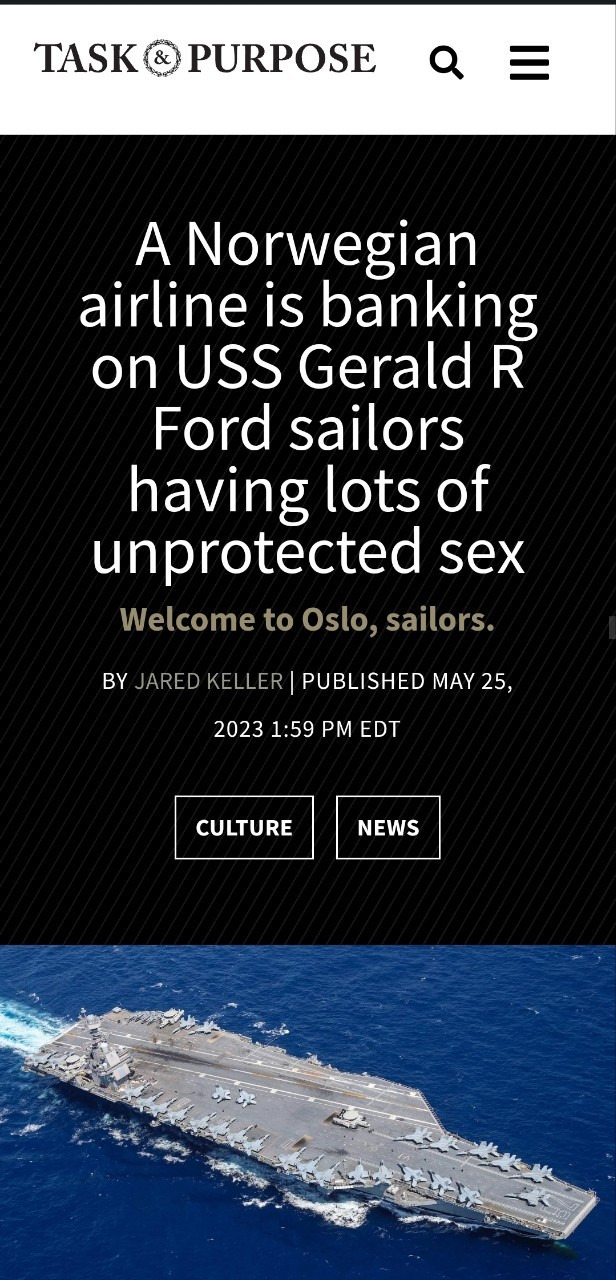

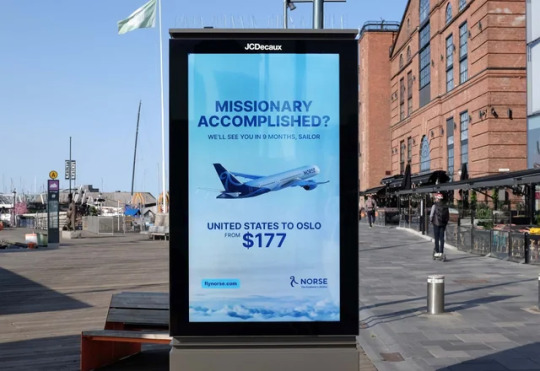
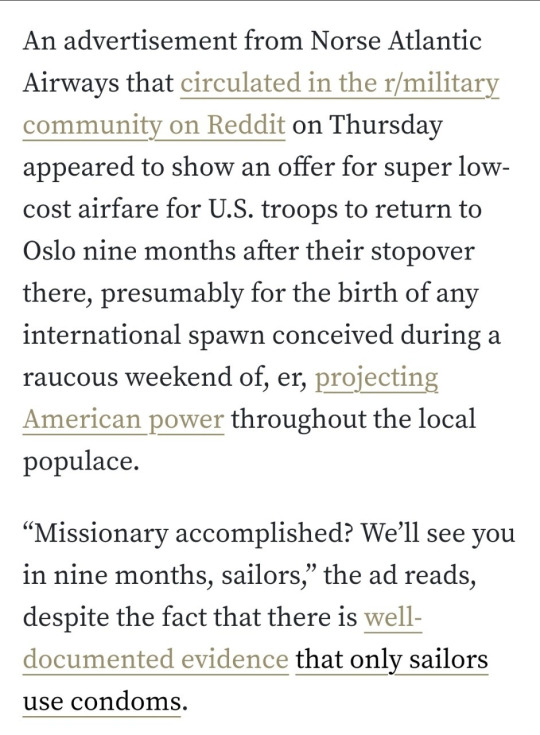
You win this round Norse Atlantic Airways, lmao
35 notes
·
View notes
Text
So the next two Gerald R. Ford Class aircraft carriers will be named USS WILLIAM J. CLINTON (CVN-82) and USS GEORGE W. BUSH (CVN-83) was announced by President Biden.
Honestly, it's disappointing to see yet another carrier named after a politician. I was hoping for another Lexington, Saratoga, Midway or something other than a president or politician but I guess that's what we're left with these days.

The next Columbia class submarine will be named USS GROTON (SSBN-828), bucking the trend for ballistic missile submarines named after states or districts.
USS JACK H. LUCAS (DDG 125) completed acceptance trials, May 18, 2023. An example of an Arleigh Burke class. (source)
Instead, the name Intrepid is going to a Flight III Arleigh Burke class guided missile destroyer (DDG-145).

An artist rendering of the future U.S. Navy Columbia-class ballistic missile submarines. (source)
source, source

#Gerald R. Ford Class#Ford Class#USS WILLIAM J. CLINTON (CVN-82)#USS WILLIAM J. CLINTON#USS GEORGE W. BUSH (CVN-83)#USS GEORGE W. BUSH#USS GROTON (SSBN-828)#USS GROTON#Columbia Class#Submarine#USS INTREPID (DDG-145)#USS INTREPID#Arleigh Burke class#Destroyer#United States Navy#U.S. Navy#US Navy#USN#Navy#January#2025#my post
40 notes
·
View notes
Photo
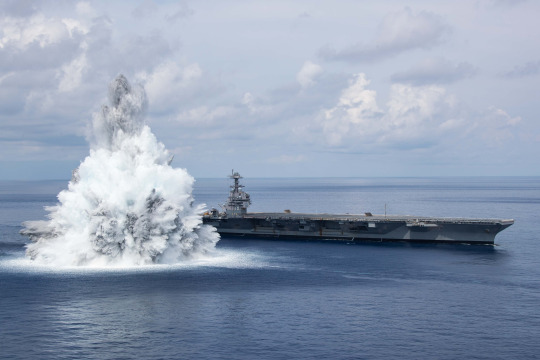
USS Gerald R Ford blast testing
15 notes
·
View notes
Text
El “Elcano” en Nueva York y el “Gerald R. Ford” en el Estrecho
De la mejor tradición náutica del mundo a lo último en portaaviones

#noticiasPROPRONews#noticias#PROPRONews#Planeta Marino#Buque Escuela “Juan Sebastián Elcano”#Portaaviones USS “Gerald R. Ford”#Nueva York#Estrecho
5 notes
·
View notes
Video
youtube
Forged by the Sea - Carrier USS Gerald R. Ford Sailors Interview
0 notes
